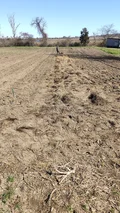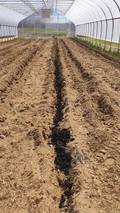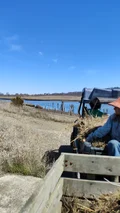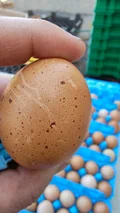TL;DR
We used the rest of a hay roll and then collected salt marsh hay to finish mulching the leeks. I had my first hand at washing all the eggs by myself.
Mulching with ‘Hay’ (straw)
After watering the greenhouse and some other morning tasks, we headed over to the dry field and spot-mulched the garlic where there were little patches of grass peaking through. Hopefully this will keep the grass from spreading but the garlic is established enough to push through. Then the rest (about a half) of the big roll was loaded onto the Ford by a John Deere 1050 wheel loader tractor which maintains permanent residence near those fields.
The ~hay roll (really straw, since hay often has seeds) was brought over to the lowest main field to mulch the leeks, but we ran out and had to use some old left over salt marsh hay near that row. Then we hooked up a small wagon to the Gator and went to collect dead grass from the salt marshes nearby for the rest of the row.
Salt marsh hay usually costs about $12-15 per square bale unless you live close to a producer and pick it up yourself (~$10). The four of us rode out and collected about 5 times that in 30mins, scuffing it up with our boots and picking it up by hand. Doing the math, this was about $34 of labor but in a pinch and as-needed to finish up a row and protect crops, is a fair trade-off. I think it’s easier to use pre-bundled straw, but when it’s on back-order and you still have to get things done, necessity is the mother of invention.
Mulching baby leeks is a delicate thing. No prevent against unnecessary weeding later in the season, we were aiming for about 4 inches thick cover. Six inches from each edge which is the same inset depth as where we planted the leeks and then the middle of the row, approximately 3 feet wide and all the way down…basically the whole row at 4 feet x 200 feet x 4 inches, or 1/3rd of 800 feet, we used approximately 275 square feet of hay on one row. Generally a square bale covers 70 square feet at a 4 inch thickness, so one row takes about 4-6 bales and some loss is expected when transfering and applying.
Cleanup
Then we took about an hour to clean up various piles of used tarp, drip line, and row cover no longer suitable for use. We are still waiting on an order which includes new semi-permiable floating row cover since there was high wind last week and some of the kale and lettuces were affected. With the black tarp, we unfurled each piece until we could assess if it was worth keeping, and also to pull any leftover garden staples out. We reused the big, pallet-sized yard-cubic bags that our potting mix comes from Vermont in for stuffing the trash items into. We consolidated bags of rocks into piles close to various beds we plan to plant into soon. Then we broke for lunch.
Egg Washing and Packaging
I was put on the task of processing the eggs today. I had carefully watched and assisted the process two weeks ago. Jamie gave us a refresher, but the process is pretty straight forward with some very specific food safety rules. Namely no cross-contamination, and at the end of the process, all packaged eggs should be flaw-free.
We use air pump bubblers in 5-gallon buckets with hot water (not scalding, we don’t want to cook them) and detergent in the ‘wash’ cycle for 15 minutes. The wash water is dumped then refilled with fresh water for a ‘rinse’ cycle for 5 minutes. At least for now, I am using a timer and learning to keep my eye on a clock. Between waiting for eggs in baskets to each go through these cycles, hand finishing the eggs that have been washed is a process of making sure that all eggs are blemish-free (no remaining dirt or surface matter, no smudges, smooth and clean to the eye). This is tedious but not hard and takes a long time, but results in rows of cartons of beautiful, farm-fresh eggs waiting to make customers happy.
I processed sixty (60) dozen, with a flaw count of about four dozen. On a good day, there’s always flawed eggs, say about two dozen or so. I think the only difference in my handling is that I’m still getting used to how full the baskets should be and how slowly they need to be lowered into the hot water. Other than that, and maybe upstream handling process, there’s few other factors I can see which results in higher number of cracked eggs at the end. All told, this took about three and a half hours just me, including cleanup and barn shutdown again.
We sell the eggs for $8 per dozen. It cost about $60 of labor and produces about 60-64 dozen twice per week with the 300 chickens producing now, and there’s more to come in order to produce enough to fill CSA and upcoming store orders. So it’s about an 7-8x value task. And people really love their eggs.
AI Hates Hay
Below is the summary of my transcribed audio notes which includes a fair bit of detail about the salt marsh hay collection and egg washing. Also note that it completely skipped the leek mulching and hay collection. Next time someone says “I think AI will help farms become far more efficient”, resist the urge to slap their face, and show them this blog where even a well-tuned and micro-managed LLM has a very hard time getting details about real field work right.
There are many use cases for AI in various currated digital arenas relating to agriculture, but the really hard work is rarely well-characterized by bits and bytes, especially those processed by systems built by people who don’t do that hard work.
Main Themes:
- Farming and agricultural work (including egg collection, washing, and polishing)
- Internship experience and responsibilities
- Daily tasks and activities involved in farm management (e.g. weeding, watering, cleaning)
Activities:
- Egg collection and washing
- Hand polishing and hand washing eggs with a damp towel
- Counting and loading eggs into totes
- Trimming egg cartons
- Weeding and preparing soil for planting
- Watering greenhouse plants
- Cleaning trash and debris from the field
New Things Not Yet Encountered:
- Special detergent used in the washing cycle
- Bubblers at the bottom of the five-gallon buckets for hot water
- Egg polishing technique using a damp towel
- Rotating eggs between wash, rinse, and dry cycles
- Using large totes to store egg cartons
Questions and Future Areas of Research:
- Improving egg washing and polishing techniques without overfilling baskets
- Preventing nail problems caused by manual labor in farming
- Optimal conditions for greenhouse plants (temperature, humidity, light exposure)
- Alternative methods for egg cleaning and polishing that reduce waste or improve results
Suggested Actions:
- Develop a more efficient system for rotating eggs between wash, rinse, and dry cycles
- Improve hand care techniques to prevent nail problems from manual labor
- Research alternative methods for egg cleaning and polishing
- Investigate optimal conditions for greenhouse plants
- Track egg quality and freshness to ensure consistent production
[end of post]
Enjoy Reading This Article?
Here are some more articles you might like to read next:








